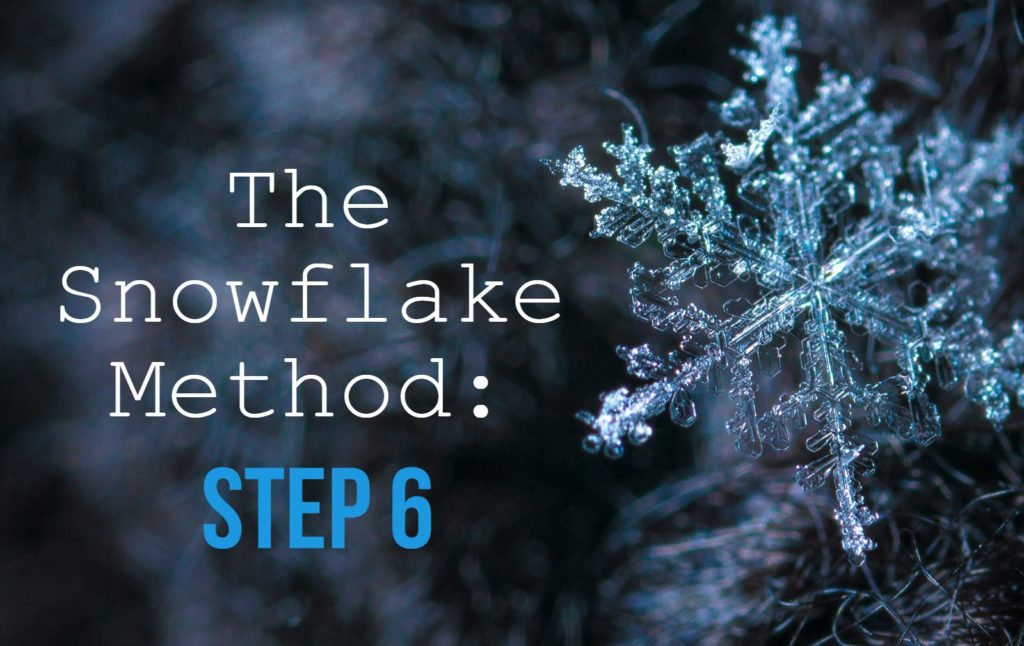
In case you missed it:
- Step 0: Come up with an idea worth writing about
- Step 1: Write a one-sentence summary of your novel
- Step 2: Expand the single sentence into a full paragraph
- Step 3: Create your main characters
- Step 4: Expand each sentence of the summary into a full paragraph
- Step 5: Hear your characters’ stories in their own words
Step 6 of the Snowflake Method
If you haven’t been following this series of posts (see above), this one might not make much sense.
To make a long story short, I decided to employ a scientific—or, at least, procedural—system called the Snowflake Method for producing my next novel, a YA portal fantasy tentatively titled Sir Larpsalot.
So far, the steps have bounced back and forth between plot development and character design, with Step 6 landing firmly in the former category. For this phase, I found myself face to face with that most odious and onerous of literary formats:
The synopsis.
What Randy recommends
I took these notes from Mr. Ingermanson’s article about the Snowflake Method:
Step 6: Expand the one-page plot summary of the novel into a four-page synopsis.
- Expand each paragraph into a full page.
- This will figure out the high-level logic of the story and help make strategic decisions.
- Refer back to earlier documents to gain insight into the story.
- Be receptive to new ideas.
- Total time: one week
What David did
Normally, sitting down to write a four-page synopsis for an unwritten novel is no easy task. I think most authors would rather jump into writing Chapter 1 than composing this Frankenstein’s monster of a half-summary, half-outline.
However, since I was working off the one-page outline I created in Step 4, it wasn’t as difficult as I feared. In fact, expanding the high-level overview into a more detailed narrative was far easier than taking a finished novel and trying to whittle it down into key plot points—which is how I approached it in the past.
Because of the constraints of the assignment, I didn’t have to worry about getting lost in the weeds. I just needed to come up with enough words to fill four pages. I found that I had a firmer grasp on the beginning than the middle, and aspects of the ending remained nebulous. Still, it was pretty darn satisfying to see the story grow in terms of depth.
And, yes, new ideas bloomed along the way.
I felt like I had some holes that needed filling when I was finished. For example, “Their return to Idelle’s cottage is uneventful” wouldn’t make for a very compelling chapter. But adding the meat to the story’s one-page skeleton helped me see more clearly where additional muscle was needed.
It was a wild ride, but to my surprise, I actually thrived.
I won’t post the entire synopsis here, but perhaps it’s worthwhile to show a portion of the exercise, specifically how the first few scenes evolved from a paragraph into a full page.
SPOILERS AHEAD
The first paragraph from Step 4:
Lorenzo, Asher, Makayla, Jon, and Trent play what is meant to be the final episode of their long-running LARP campaign. As Sir Larpsalot, Elvish Presley, Brutus the Bullheaded, Master Prospero, and Tom Foolery (respectively), they battle the “big bad.” Sir Larpsalot is tricked, and the party loses the upper hand. Shortly thereafter, Trent twists his ankle, and they are forced to end their session. An argument about the future of the group—given Asher’s impending move and the start of high school around the corner—breaks out. Everyone goes their separate ways.
The first page of Step 6:
Sir Larpsalot, Elvish Presley, Brutus the Bullheaded, Master Prospero, and Tom Foolery are betrayed by their traveling companion, who reveals himself to be the dreaded Lord of the Rangs. The villain’s first attack misses, and he raises his hands in surrender. Sir Larpsalot stays his sword, but the magical boomerang returns, striking the paragon down.
An epic battle unfolds, but the scene is cut short when Brutus and Tom (Mak and Trent) run into each other and the latter twists his ankle.
The action stops suddenly, and the kids break character. Trent is mad at Mak, though she is angry with their merciful party leader (Lorenzo). Jon tries to take command (for the umpteenth time), but Trent shuts it all down by reminding them that this is their last adventure. He’s not interested in rescheduling the final battle because he’s done with larping. Even if Asher weren’t moving away, he’d want to quit before they start high school in a couple of weeks.
Trent storms/limps off, and Jon reluctantly joins him. Asher is sad that his masterpiece fell apart; he doesn’t know how to feel about learning his friends won’t larp—and that the characters will, in essence, die—after he leaves. Lorenzo and Mak offer to stick around and help Asher clean up, but he wants to be alone.
The next step
Regarding the timeline, it did, in fact, take me the prescribed week to complete this step, working from 5/1/19 to 5/7/19. Wow, that was almost exactly a year ago!
Since then, I’ve completed the remaining four steps of the Snowflake Method, did a round of edits on the rough draft, received feedback from my young beta readers, made more revisions, and sent the book out for a second round of beta (gamma?) reading, this time from older readers.
I’ll continue to summarize the steps of this experiment in the months to come, but suffice it to say, I’m pleased with my progress.
Do I attribute my success to the Snowflake Method?
You’ll just have to wait and see, continuing next month when I take on Step 7: creating full-fledged character charts.



Leave a comment